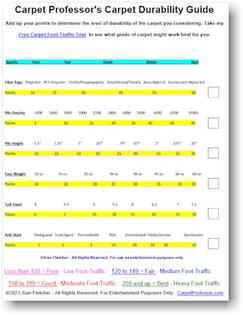How To Choose New Flooring Like A Pro!
List of Preferred Local Flooring Stores
(Free Information by Consumer Advocate - No Flooring Sales)
Carpet Specifications Explained
 Understanding
Carpet Specifications is the ONLY sure-fire way for you to know if the carpet
you select is able to tolerate your level of foot traffic. Knowing
just a little bit
about carpet specifications can help you determine how long your new carpet will last and retain its like-new
appearance.
Understanding
Carpet Specifications is the ONLY sure-fire way for you to know if the carpet
you select is able to tolerate your level of foot traffic. Knowing
just a little bit
about carpet specifications can help you determine how long your new carpet will last and retain its like-new
appearance.
Many homeowners choose a grade of carpet not designed to meet their needs and goals. They make their choice based on cost, softness and appearance rather than quality. It's hard to tell if one carpet is more durable than another just by looking at it or feeling how soft it is. All carpets look and feel great when new. The only sure-fire way to tell the difference in quality between two different carpets is to compare carpet specifications side by side.
The Carpet "Specification" Label Explained
On the back of almost every retail Carpet Sample there should be a manufacturer's label that shows...
-
Type of Fiber
-
Pile Density
-
Face-Weight
-
Pile Height
-
Tuft Twist
This is must-have information that every homeowner needs to help determine how durable the carpet is, to help determine its value; and determine whether or not it would be a suitable choice to meet your needs, goals and lifestyle.
How and Where to Locate Carpet Specifications
The Carpet Warranty Label
Other information shown on the warranty label:
-
Anti-stain treatments that may have been applied (Scotchgard?)
-
Manufacturer's brand name (Shaw, Mohawk, Dream Weaver)
-
Carpet style name (e.g., Enchanted Evening II)
-
Color name or color number (Emerald Green or EG-124)
-
Warranty Wear Limits (# of Years)
Learn more about Carpet Warranties
1. What is Carpet Pile Height?
If you want your carpet to resist matting and crushing of the pile, I recommend a Carpet Pile Height of 3/4" or less. On stairs, I recommend a Carpet Pile Height of 1/2" or less and a Carpet Padding Thickness of 7/16" or less and a Pile Density Rating of at least 8-pounds. The Pile Height measurement is not always shown on the carpet sample, however all you need is a tape measure. Don't include the carpet backing, just measure the soft fibers from the backing up.
Keep The Pile Low
A Shorter Pile-Height makes for a more durable carpet. It also makes the carpet easier to clean, more stain resistant and less prone to matting and crushing of the pile.
Commercial Grade Carpet is known for having a short pile-height and a dense pile. The majority of commercial carpet is glued down to the floor without any padding. This is the secret for success used in offices, airports, casinos and banks to name a few. It's not soft underfoot without padding, but it's why it can tolerate heavy foot traffic, resist stains and is so easy to keep clean.
2. What is Carpet Pile Density?
Pile Density is a mathematical calculation based on the fiber Face-Weight and Pile Height. Think of a heavily wooded forest. The more closely packed together the trees are, the more dense the forest is. The same goes for carpet.
You want a carpet with the tufts packed tightly together. This helps the carpet resist matting and crushing of the pile and increases durability and longevity. Pile Density is a major factor to consider when it comes to carpet durability too, almost as important as the type of Carpet Fiber you select.
3. What is Carpet Face-Weight?
Face-weight is the actual weight of the fiber used to manufacture the carpet pile, but does not include the weight of the carpet backing. Fiber Face-weight is not the same as Total Carpet Weight, which includes the weight of the carpet backing and the fiber face-weight.
Most carpets have a face-weight somewhere between 20 ounces and 100 ounces, but the typical face-weight for residential carpet is 30 to 60 ounces. A higher face-weight does not automatically mean the carpet is a better grade; is a higher quality; is more durable; or is more costly.
These three carpet specs are mathematically related which is good news for you. If you can figure out one or two, out of the three specs, then you can easily figure out the other specifications using the formulas I reveal below!
4. What is Tuft Twist?
Carpet fiber is either extruded or twisted to form a single strand or "filament". These filaments are similar in size to a human hair. A bunch of filaments are grouped together and twisted together to form Tufts. While the fiber strands are twisted, heat is applied to "set" them permanently, hence the term "heat set" or "perm". The tighter the tufts are twisted together the longer the carpet is able to maintain its "like-new" appearance. The Tufts illustrated below are one-inch long. I have used two colors to help show the number of twists.
The Tuft Twist Rating
Based on the number of twists per lineal inch of tuft.
This Tuft has 7 twists and is a sign of a more durable carpet. Frieze styles have tufts similar to this and cost about $35 per square yard and up, or $3.88 per square foot. More expensive carpet styles tend to have higher Tuft-Twist ratings.
This Tuft has 4 twists and is not as durable or long lasting. Low to medium grade Plush and Textured Plush styles often have a tuft twist rating similar to this and range from $15 per square yard or $1.66 per square foot and up.
Carpets rarely wear out from fiber loss, they just start to mat down; gradually lose the luster and shine; and just start to look bad or ugly. Once the tufts have blossomed and become matted down, the damage cannot be undone, reversed or repaired.
Learn more Carpet Manufacturing Specifications Explained
Points To Remember:
-
The Tuft Twist Rating is based on the number of twists per lineal inch of the tuft. If a tuft is only a half inch long, you would need to double the twist count to determine the twist rating.
-
The Tuft Twist count usually range from 3.0 to 7.5. Lesser quality carpets will have a lower number of Tuft Twists. The higher the Tuft Twist the longer your new carpet will retain its like-new appearance.
-
Carpet "Blossom" or blooming is a common carpet condition where the Tuft begins to un-twist and starts to look worn out, matted down and ugly!
-
Some carpets with a lower Tuft twist rating may feature a higher pile density to try to compensate. A higher Pile Density will help increase the longevity and durability. Manufacturers of Polyester and PET Polyester carpets often use this strategy to lower costs and increase carpet durability with limited results.
-
You will find that carpets made from PET Polyester and Polyester fibers are less expensive than a Nylon counterpart and yet feel softer and provide a higher pile density than Nylon. Polyester is less inexpensive to manufacture. This is why they can afford to create a carpet that is more dense and less costly than Nylon.
Pile Height, Density and Face-Weight
Not having all three of these specs readily available to you might not be such a big problem if you can find or even closely guesstimate two out of three carpet specifications, then you can calculate the third specification...by using simple mathematics!
Below I explain in detail what you need to do, and how you can quickly and easily figure out for yourself all the carpet specifications you need to acquire, even if the carpet retailer or salesperson refuses to give you hardly any information at all!
Why is Tuft Twist Important?
The Number of Tuft Twists is an important factor to making sure your carpet retains its like new appearance longer. Frieze styles tend to have a higher tuft twist (over 6 twists per lineal inch) and is why they are well-known for their durability and retaining a like-new appearance longer than many other styles.
Count The Twists Yourself!
When you look at a potential carpet, you can look closely at the tuft and count the number of twists yourself. Just remember that the tuft twist rating is based on one inch of tuft. For example, if the tuft is 1/2" long and has 3 twists, then the tuft twist is 6. Looped Berber carpets have twisted tufts too, but it is very hard to count them with the naked eye. Most looped Berber styles will state the Tuft Twist Rating posted on the back of the carpet sample or shown on the manufacturer's spec sheet. (ask for it)
Matting and Crushing
Carpets with a lower Tuft Twist Rating (of 3 to 5), tend to untwist or “blossom” at the tuft tips more quickly, thus creating a worn out, frizzy looking or matted down appearance.
Can I Calculate Carpet Specifications Myself?
Here is how you can figure out carpet specifications by using simple math formulas.
1. Let's assume you don't know what the Pile Density rating is of a carpet you are interested in buying, but you do know the Face-Weight and Pile Height:
-
Use Specification Rule #1 below...
2. If you don't know what the Face-Weight rating is of a carpet you are interested in buying, but you do know the Pile Height and Pile Density:
-
Use Specification Rule #2 below...
3. If you don't know what the Pile Height is of a carpet you are interested in buying, but you do know the Face-Weight and the Pile Density:
-
Use Specification Rule #3 below...
Carpet Specification Rule # 1:
Formula: Face-Weight x 36 ÷ Pile Height = Pile Density
-
Face-Weight is the weight of the surface fiber in ounces. (20 to 100)
-
Pile Height is a fraction turned into a decimal (3/4" = .75).
Example: (30 X 36 ÷ 0.50 = 2160)
In this example, what we know is that the face weight is 30 ounces and the pile height is 0.5 (one half inch).
We can now use Rule #1 to calculate the Pile Density Rating.
__________________________________________________________
Carpet Specification Rule # 2:
Formula: Density x Pile Height ÷ 36 = Face Weight
-
Pile Density is a number based on the Face-Weight and Pile Height. (Range 1000 to 9000)
-
Pile Height is a fraction turned into a decimal ( 3/4" = .75). See Conversion Chart below.
Example: (2160 X 0.50 ÷ 36 = 30)
In this example, we know the Pile Density is 2160 and the pile height is 0.5" (1/2").
We can now use Rule #2 to calculate the Face-Weight in Ounces.
__________________________________________________________
Carpet Specification Rule # 3:
Formula: 36 ÷ Density x Face-Weight = Pile Height
-
Pile Density is a number determined by the Face-Weight and Pile Height. (Range 1000 to 9000)
-
Face-Weight is the weight of the surface fiber in ounces. (20 to 100)
Example: (36 ÷ 2160 X 30 = 0.5
In this example, we know the Pile Density is 2160 and the Face Weight is 30 Ounces.
We can now use Rule #3 to calculate the Pile Height in decimal form.
__________________________________________________________
Decimal to Fraction Conversion Table
0.0625 = 1/16"
0.125 = 1/8"
0.1875 = 3/16"
0.25 = 1/4"
0.3125 = 5/16"
0.375 = 3/8"
0.4375 = 7/16"
0.5 = 1/2"
0.5625 = 9/16"
0.625 = 5/8"
0.6875 = 11/16"
0.75 = 3/4"
0.8125 = 13/16"
0.875 = 7/8"1.0 = 1"
1.0625 = 1-1/16"
1.125 = 1-1/8"
__________________________________________________________
Carpet Prices Are Going Up!
Along with everything else we need to buy today... Carpet, Padding and Installation costs are all going up significantly. When you walk into a carpet store, the price you see posted on the carpet sample is for the carpet only. It does not include padding or installation.
The price shown on the carpet sample also does not include any extra products or services your job might require. So if the carpet only price is $3.49 per square foot, your final cost could be closer to $5.00 per square foot (or more) after adding in the cost of padding and installation. Take My Free Carpet Foot-Traffic Test
What is The P.A.R. Carpet Rating System?
What is PAR rating for carpet? The PAR carpet rating system, created by Shaw Industries, rates their carpet's durability level based on a typical “family of four” scenario. Homeowners are expected to understand that the higher the PAR Rating number the more durable the carpet. On the back of their carpet samples they provide a number between 1 and 5, that will tell you the level of durability of that particular carpet. With dozens of carpet grade levels and qualities to choose from, how can this limited system possibly cover them all effectively? I think the PAR rating system falls way short of being an accurate or realistic guide for consumers. Learn more about the PAR Carpet Rating System.
Carpet Professor's Carpet Durability Guide
 If you want to make
wise and informed choices you need to know
what grade or quality level of carpet you need to buy for your home. (Click
on the image to view or print)
If you want to make
wise and informed choices you need to know
what grade or quality level of carpet you need to buy for your home. (Click
on the image to view or print)
What is your foot traffic score? Here's a simple test to help you determine your level of foot-traffic you have in your home. It just takes a minute or two to take my free Carpet Foot-Traffic Test.
Then you can use my free Carpet Durability Chart to help determine if the carpet you are considering is capable of meeting your needs and goals.
Learn more:






